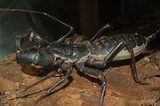
Uropygid
Overview
Arachnid
Arachnids are a class of joint-legged invertebrate animals in the subphylum Chelicerata. All arachnids have eight legs, although in some species the front pair may convert to a sensory function. The term is derived from the Greek words , meaning "spider".Almost all extant arachnids are terrestrial...
order comprising invertebrates commonly known as vinegaroons (or vinegarroons). They are often called uropygids in the scientific community after the former order Uropygi (which originally also included the order Schizomida). They are also known as whip scorpions because of their resemblance to true scorpion
Scorpion
Scorpions are predatory arthropod animals of the order Scorpiones within the class Arachnida. They have eight legs and are easily recognized by the pair of grasping claws and the narrow, segmented tail, often carried in a characteristic forward curve over the back, ending with a venomous stinger...
s and because of their whiplike tails.
The name "uropygid" means "tail rump", from Greek
Greek language
Greek is an independent branch of the Indo-European family of languages. Native to the southern Balkans, it has the longest documented history of any Indo-European language, spanning 34 centuries of written records. Its writing system has been the Greek alphabet for the majority of its history;...
(), from () "tail" and () "rump" referring to the whip-like flagellum
Flagellum
A flagellum is a tail-like projection that protrudes from the cell body of certain prokaryotic and eukaryotic cells, and plays the dual role of locomotion and sense organ, being sensitive to chemicals and temperatures outside the cell. There are some notable differences between prokaryotic and...
on the end of the pygidium
Pygidium
The pygidium is the posterior body part or shield of crustaceans and some other arthropods, such as insects and the extinct trilobites. It contains the anus and, in females, the ovipositor...
, a small plate made up of the last three segments of the abdominal exoskeleton
Exoskeleton
An exoskeleton is the external skeleton that supports and protects an animal's body, in contrast to the internal skeleton of, for example, a human. In popular usage, some of the larger kinds of exoskeletons are known as "shells". Examples of exoskeleton animals include insects such as grasshoppers...
.
Vinegarroons range from 25 millimetre in length, with most species not longer than 30 mm (1.2 in); the largest species, of the genus Mastigoproctus
Mastigoproctus
Mastigoproctus is a genus of whip scorpions. Native to the rain forest regions of northern South America, these whip scorpions can reach a length of up to and can weigh over...
, reaching 85 mm (3.3 in).
Like the related orders Schizomida, Amblypygi, and Solifugae
Solifugae
Solifugae are an order of Arachnida, known as camel spiders, wind scorpions and sun spiders or solifuges, comprising more than 1,000 described species in about 153 genera...
, the vinegarroons use only six legs for walking, having modified their first two legs to serve as antennae-like sensory organs.
Unanswered Questions

